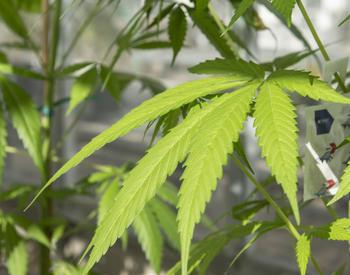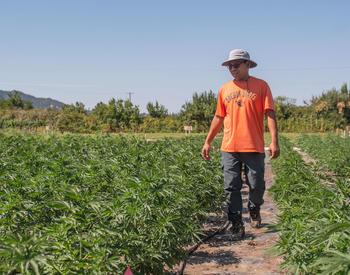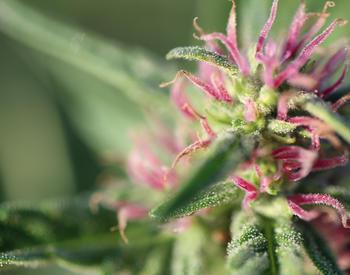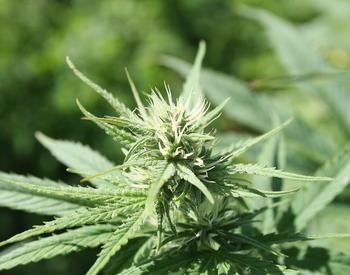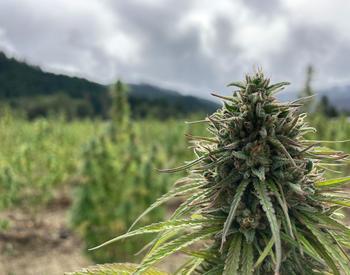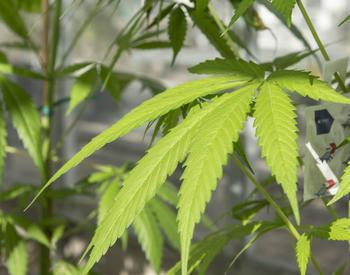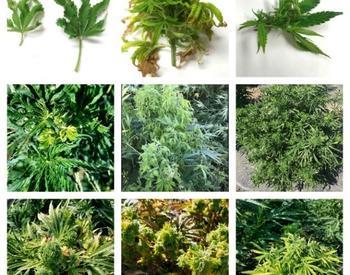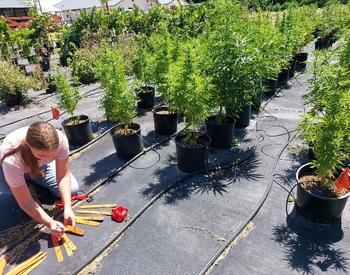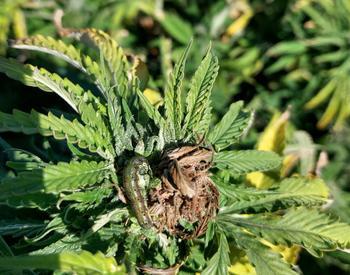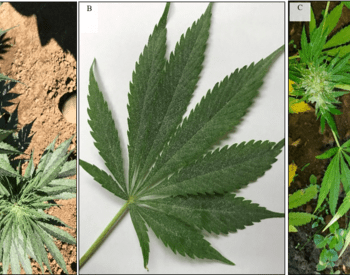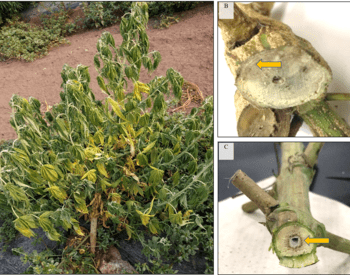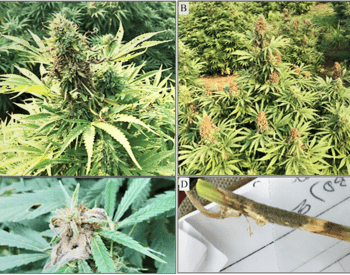Hemp (Cannabis sativa) is susceptible to plant pathogens, especially at the early stages of plant development. Diseases that impact hemp at the early stages of growth include seed rot, damping-off, and rot of roots, crown, and/or stem portions.
Pathogens associated with hemp seeds (seed-borne) or soil (soil-borne) may cause seeds to rot before germination, or germinating seedlings may die before or after plants emerge from the soil, known as pre-emergence and post-emergence damping-off, respectively.
In post-emergence damping-off, young plants collapse, and stems are brownish with the decay starting at the soil line (Figure 1D) or the top of the growing medium (Figures 1A and B), and then the decay moves upwards along the stem. Brown, rotted roots may also be found on plants with damping-off.
Environmental conditions that are less than ideal for hemp plant growth generally favor seed rot and damping-off, such as cold, wet soil conditions. Damping-off is more prevalent in poorly drained and excessively compacted, cold soils.
Planting poor quality seed increases seed rot and damping-off problems as does planting seed too deep in wet, heavy soil. High relative humidity in the greenhouse promotes damping-off so reducing the relative humidity inside greenhouses by improving air circulation is important for managing damping-off.
Pathogens that incite damping-off may also cause root rots of seedlings (Figures 1C and E). Roots appear discolored at early stages and later turn brown to black with the lateral roots typically affected first but lateral roots may be absent.
Aboveground portions of plants with root rot may be stunted; seedlings can sometimes wilt and plants often die if root rot is severe on young plants. Foliage can take on a yellowish coloration and the lower portion of stems can turn brown to black, including the inner pith tissues.
Pythium is a fungus-like microorganism known as an oomycete that requires wet soil conditions while the others are true fungi and can cause disease under drier soil conditions compared to Pythium. All four generally have a broad host range, and except for Botrytis, these are common microorganisms in the soil. These pathogens can survive on plant debris and persist in soil for years as durable structures including spores and sclerotia (compact masses of mycelium).
Fusarium species are also commonly seed-borne. Pathogens may also survive on contaminated potting containers and plant trays. Pathogens can be transported into a greenhouse or a field via wind currents that move spores or blow infested soils, or as contamination on equipment, tools, footwear or in contaminated water. For more information on diseases that affect hemp, see the Pacific Northwest Plant Disease Management Handbook.
Close examination of plants exhibiting delayed growth or stunting, abnormal yellowing or browning of leaves, or stem discoloration is important to determine if a pathogen is present. It is usually necessary to dig up young plants in order to examine the roots and crown portions to evaluate for rot.
Growers may need an expert for the diagnosis and can submit samples of diseased plants to a plant clinic. Plant clinics (public and private) listings along with information on how to submit plant samples and associated fees for testing can be found in the Pacific Northwest Plant Disease Management Handbook.
Cultural management of seedling diseases in the greenhouse and field
- Monitor seedlings and young plants at least once a week for disease symptoms.
- Ensure that pots and trays are clean; if reusing containers, wash pots to remove any used soil and plant debris followed by a 10% bleach treatment.
- Use of pasteurized growing medium is recommended.
- Avoid high levels of organic matter in the planting medium.
- Avoid establishment of hemp fields in soils where seed rot, damping-off or root rot has occurred in the previous three years.
- Long rotations are required to reduce the population of pathogenic Fusarium species in infested fields; rotate out of hemp for at least three years.
- Select planting sites and dates to take advantage of warm soils.
- Plant quality seeds with high germination rates and good vigor.
- Place plants on benches rather than the floor inside greenhouse structures.
- Maintain warm soil temperatures during germination through plant emergence.
- Practice optimum water management, especially avoiding overwatering the first few weeks after planting.
- Avoid high relative humidity inside greenhouses. Reduce the relative humidity by improving air circulation.
- Cleaning of planting tools and equipment between fields or groups of plants so that there is no remaining soil or plant residues will help to minimize pathogen spread.
- Remove and destroy diseased plants while avoiding contact with healthy plants. Burn or deeply bury infected plants. Clean hands and gloves to ensure that no pathogens remain.
- Do not reuse potting media from diseased plants.
- When propagating by cuttings, ensure that the mother plants do not have any disease symptoms and that plants are healthy and vigorous.
- Apply bio-fungicides to suppress root rot and damping-off. Follow directions on the pesticide label. See the Oregon Department of Agriculture Hemp Pesticide Guide List.
